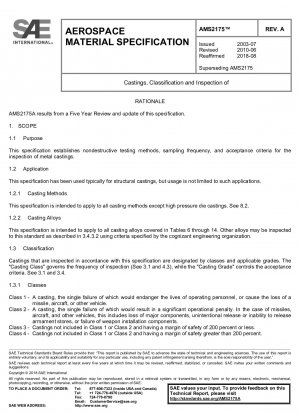SAE AMS2175A-2018
Castings@ Classification and Inspection of
- Standard No.
- SAE AMS2175A-2018
- Published By
- SAE - SAE International
- Latest
- SAE AMS2175A-2018
- Scope
- "Purpose This specification establishes nondestructive testing methods@ sampling frequency@ and acceptance criteria for the inspection of metal castings. Application This specification has been used typically for structural castings@ but usage is not limited to such applications. Casting Methods This specification is intended to apply to all casting methods except high pressure die castings. See 8.2. Casting Alloys This specification is intended to apply to all casting alloys covered in Tables 6 through 14. Other alloys may be inspected to this standard as described in 3.4.3.2 using criteria specified by the cognizant engineering organization. Classification Castings that are inspected in accordance with this specification are designated by classes and applicable grades. The ""Casting Class"" governs the frequency of inspection (See 3.1 and 4.3)@ while the ""Casting Grade"" controls the acceptance criteria. See 3.1 and 3.4. Classes Class 1 - A casting@ the single failure of which would endanger the lives of operating personnel@ or cause the loss of a missile@ aircraft@ or other vehicle. Class 2 - A casting@ the single failure of which would result in a significant operational penalty. In the case of missiles@ aircraft@ and other vehicles@ this includes loss of major components@ unintentional release or inability to release armament stores@ or failure of weapon installation components. Class 3 - Castings not included in Class 1 or Class 2 and having a margin of safety of 200 percent or less. Class 4 - Castings not included in Class 1 or Class 2 and having a margin of safety greater than 200 percent. Grades Castings@ or sections of a casting@ shall be of the following grades: Grade A - The highest quality grade of casting@ or area of a casting@ with minimum allowable discontinuities and very difficult to produce except in local areas. Grade B - The second highest quality grade of casting@ or area of a casting@ which allows slightly more discontinuities than Grade A@ and difficult to produce@ except in local areas. Grade C - A high quality grade of casting@ or area of a casting@ that can be consistently produced. Grade D - The lowest quality grade of a casting@ or area of a casting@ that is easily produced and is used primarily for low stress or noncritical areas adjacent to the higher graded areas."
SAE AMS2175A-2018 history
- 1970 SAE AMS2175A-2018 Castings@ Classification and Inspection of
- 2010 SAE AMS2175A-2010 Castings, Classification and Inspection of
- 2003 SAE AMS2175-2003 Castings, Classification and Inspection of
